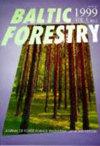聚氨酯和丙烯酸涂料对浸渍云杉木材(Picea abies Karst)的表面保持性及其与几种木材防腐剂的比较
IF 0.6
4区 农林科学
Q3 FORESTRY
引用次数: 0
摘要
天然云杉木材对生物降解和天气影响的抵抗力较低,因此需要进一步保护,以满足外部类别木材的耐久性要求。根据木材防腐剂标准,涂料作为防水剂属于OS(有机溶剂)类防腐剂。这种涂层具有防水功能,而且无毒,因此这些优点使其可以像浸渍材料一样使用。本工作的目的是使用基于聚氨酯和丙烯酸-异氰酸酯树脂的涂层材料,采用“双真空工艺”对云杉木(Picea abies Karst)进行浸渍,并测定木材中的涂层量。浸渍效率通过保留率来表示。将涂层保留率与最常用的防腐剂的最低标准规定保留率进行比较,即木馏油、砷酸铜铬(CCA)和水性富铜体系,如唑铜(CBA-A,Thanalite E),以显示所应用的双真空工艺的效率。涂层保留率与木馏油的最低规定保留率没有显著差异,其含量为118-149 kg/m3,或比CCA或CBA-A的推荐保留率高32-38倍,用于外部使用的木材保护。聚氨酯和丙烯酸木材涂料可以成功地用于木材浸渍目的。关键词:浸渍、保留、云杉木、聚氨酯涂料、丙烯酸-异氰酸酯涂料。本文章由计算机程序翻译,如有差异,请以英文原文为准。
Surface retention of polyurethane and acrylic coatings on impregnated spruce wood (Picea abies Karst) and comparison with some wood preservatives
The natural spruce wood has low resistance against biological degradation and weather effects, so further protection is required, up to meeting the durability requirements for wood used in exterior classes. According to the wood preservatives standards, coatings as water repellents belong to the group OS (organic solvent) preservatives. The coatings have a water-repellent function, and they are not toxic, so these advantages make them usable like impregnation material. The objective of this work is impregnation of the spruce wood (Picea abies Karst) using the “Double vacuum process” with coating material based on polyurethane and acrylic isocyanate resins and determinate the coatings quantity in wood. The impregnation efficiency is expressed through the retention. The coatings retention is compared with the minimal standard prescribed retention of the preservatives, most frequently used, namely creosote, copper chrome arsenate (CCA) and waterborne copper-rich systems like copper azole (CBA-A, Thanalite E), to show the efficiency of the applied double vacuum process. The coating retention is not significantly different from the minimum prescribed retention of creosote and amounts 118 - 149 kg/m3 or 32 to 38 times higher than the recommended retention of CCA or CBA-A for wood protection in the exterior use. The polyurethane and acrylic wood coatings can be successfully applied for wood impregnation purposes. Key words: impregnation, retention, spruce wood, polyurethane coatings, acrylic isocyanate coatings.
求助全文
通过发布文献求助,成功后即可免费获取论文全文。
去求助
来源期刊

Baltic Forestry
农林科学-林学
CiteScore
1.60
自引率
0.00%
发文量
23
审稿时长
>12 weeks
期刊介绍:
The journal welcomes the original articles as well as short reports, review papers on forestry and forest science throughout the Baltic Sea region and elsewhere in the area of boreal and temperate forests. The Baltic Sea region is rather unique through its intrinsic environment and distinguished geographical and social conditions. A temperate climate, transitional and continental, has influenced formation of the mixed coniferous and deciduous stands of high productivity and biological diversity. The forest science has been affected by the ideas from both the East and West.
In 1995, Forest Research Institutes and Universities from Estonia, Latvia and Lithuania
joined their efforts to publish BALTIC FORESTRY.
 求助内容:
求助内容: 应助结果提醒方式:
应助结果提醒方式:


